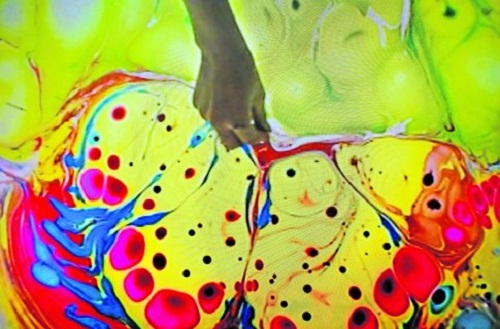Painting on Water May 6, 2016
Author: Beach Combing | in : Medieval , trackback
The strangest painting technique ever employed? The Mountain Man of Fan-Yang, an artist from T’ang China perhaps holds the prize in what for Europe would have been the early Middle Ages. The Mountain Man’s preferred method was as follows: as you remember this think about a French or Irish monk inking a manuscript. Mountain man would dig a pit ten feet by ten feet. He would then fill said pit with water and let the water absorb into the ground continuously filling the pit. Then, the fun really began.
‘He prepared his pigments, ink, and inkstones. Upon first lifting his brush, he ground his teeth a good while [Loved this]. Then he gave the brush free rein to sweep across the water’s surface. If one came close and looked, all that was to be seen was a chaotic swirl of colors and water. After the passage of two days [once the water had gone?], he made a rubbing [from the marled floor of the pit, to which the pigments would have adhered] on four lengths of fine-mesh pongee [thin woven cloth]. After a short period of time he lifted the rubbing out and presented it to view: aged pines, bizarre rocks, people, animals, houses, trees-none but were perfectly done.’
So to be clear (!) a pit full of water; Mountain Man paints on water; the water recedes leaving the paints and colours on the bottom of the pit; Mountain Man then takes a transfer onto pongee and has created his painting.
There is also an eighth-century (?) poem translated by Paul Kroll from who our knowledge about Mountain Man comes.
Mountains lofted and lifted,
Waters limpid and deep-
In full flood and free flow his single brush ploughs;
Each plant, each tree, is a refuge for divine luminaries.
Suddenly it is as though there are beings in the void,
And there are sounds among the beings.
Again, it’s as though there were a stranger homeward-gazing from a distant road,
Circling in dream the mountains and streams where his person cannot go.
The ‘divine luminaries’ will be Chinese elementals. If the paintings were even half as good as the poem then their loss to humanity is a tragedy, one with which historians are all too familiar.
Other curious painting techniques: drbeachcombing AT yahoo DOT com
Source: Paul, W. Kroll, ‘An Addendum to the History of T’ang Art: Painting on Water’, Journal of the American Oriental Society 103 (1983), 599-600


